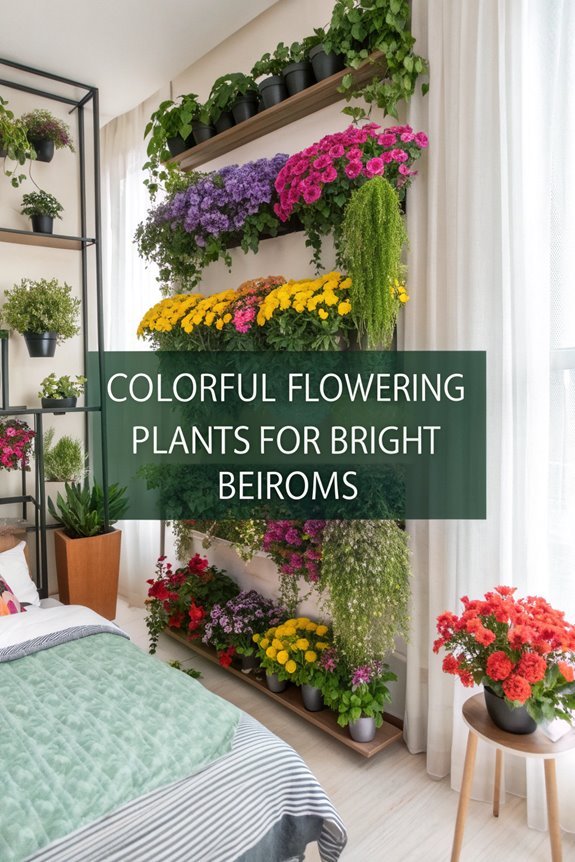20 Wildflower Ideas for Naturalistic Rock Gardens
For a colorful and charming rock garden, wildflowers are ideal, thriving in rocky, well-drained soil. Picture vibrant Black-Eyed Susan alongside delicate Harebell, attracting butterflies while being drought-tolerant.
Ready to discover outstanding wildflower options for your garden? Let’s dive in!
Black-Eyed Susan (Rudbeckia Hirta)

If you’re looking to add a splash of sunshine to your rock garden, the Black-Eyed Susan (Rudbeckia hirta) is a fantastic choice!
These cheerful yellow flowers, with their dark centers, practically beam with joy. They thrive in sunny spots and can handle poor soil—talk about low maintenance! Just plant them in clumps for a more vibrant display.
Plus, they attract butterflies and bees, making your garden a lively spot for pollinators. Just be careful; they might steal the show!
With their hardy nature and bright personality, Black-Eyed Susans are sure to make you smile every time you step outside.
Purple Coneflower (Echinacea Purpurea)
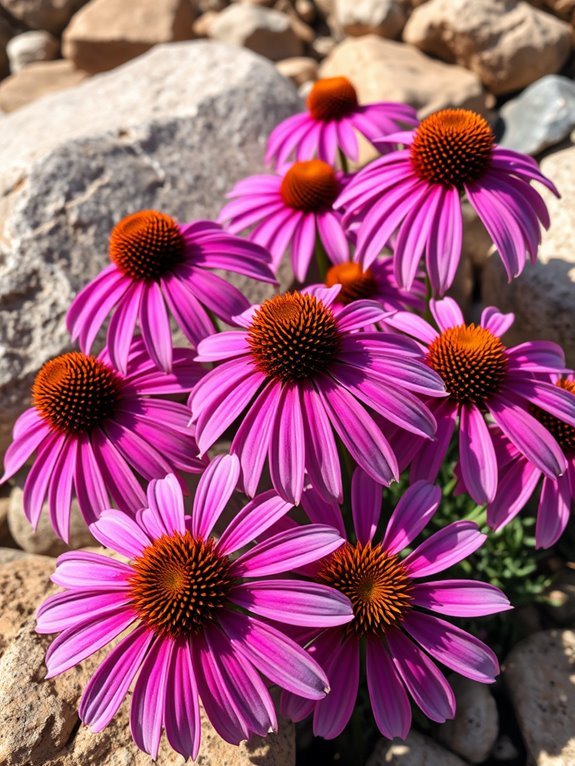
When you think of adding a pop of color to your rock garden, the Purple Coneflower (Echinacea purpurea) should definitely come to mind!
These stunning blooms not only brighten your space but also attract pollinators, making them the life of the garden party.
Plus, they’re easy to grow!
- Flourishing in well-drained soil
- Thriving in full sun
- Drought-tolerant once established
- Making great cut flowers!
Wild Bergamot (Monarda Fistulosa)
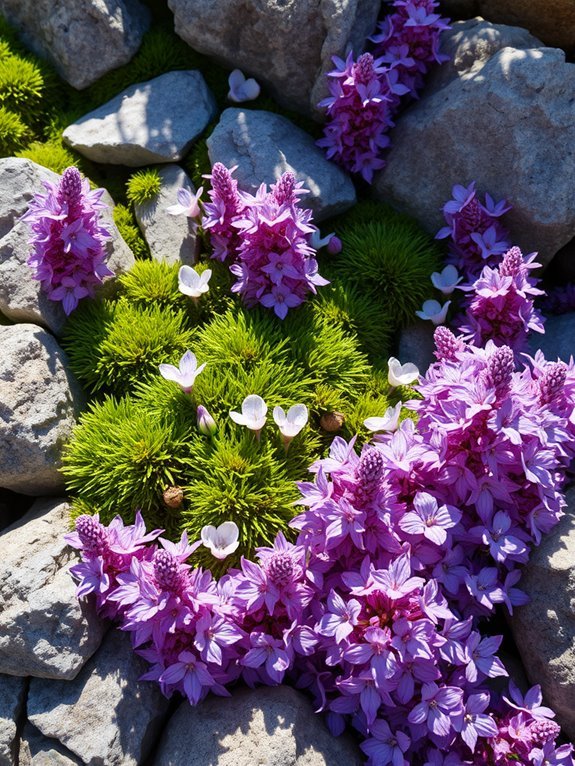
While the Purple Coneflower brings vibrant color to your rock garden, Wild Bergamot (Monarda fistulosa) adds a delightful twist with its unique fragrance and charming blooms.
This perennial beauty attracts bees and butterflies, making it a pollinator’s paradise! You’ll love how its lavender-pink flowers sway in the breeze, creating a whimsical dance.
Plus, the aromatic leaves are perfect for making herbal teas—who knew gardening could be so invigorating?
Plant Wild Bergamot in well-drained soil and watch it thrive! It’s like inviting a little piece of nature’s magic right to your backyard.
Get ready for a fragrant adventure!
Blanket Flower (Gaillardia Aristata)
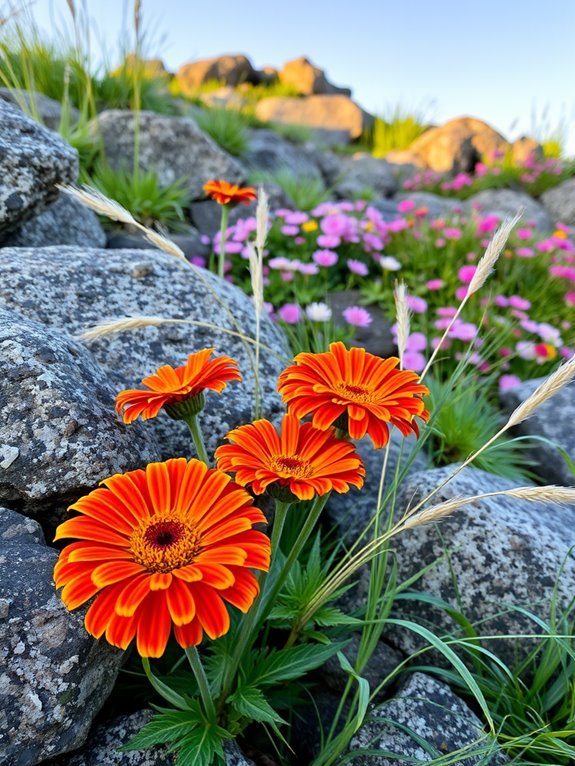
Imagine stepping into your rock garden and being greeted by the cheerful, sun-kissed blooms of Blanket Flower (Gaillardia aristata).
These vibrant flowers bring a burst of color and joy, making your garden feel alive. Their daisy-like petals, ranging from fiery reds to sunny yellows, are sure to catch anyone’s eye. Plus, they’re perfect for attracting butterflies and bees!
- Drought-tolerant and low-maintenance
- Blooms from early summer to fall
- Attracts pollinators galore
- Great for rock crevices and borders
With Blanket Flowers, your garden will shine brighter than a sunbather at the beach!
Prairie Smoke (Geum Triflorum)
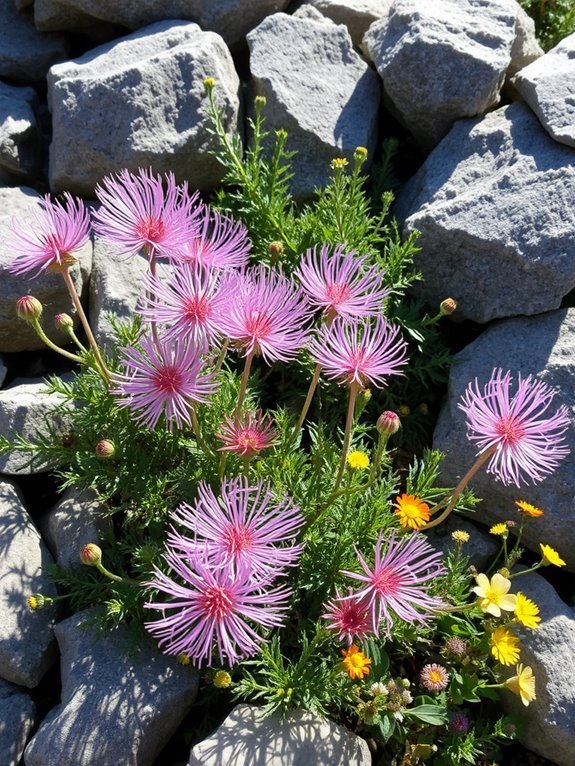
Prairie Smoke (Geum triflorum) is like a rejuvenating change in your rock garden, bringing a unique charm that’s hard to resist.
With its feathery seed heads and delicate pink flowers, this perennial adds a whimsical touch. You’ll love how it dances in the breeze, almost as if it’s waving at passersby.
Prairie Smoke thrives in well-drained soil and full sun, making it a perfect match for your rocky landscape. Plus, it’s low-maintenance! Just sit back and enjoy the show.
Who knew a plant could offer such delightful personality? Trust me, your garden will thank you for this playful addition!
Butterfly Weed (Asclepias Tuberosa)

When you think about adding a splash of color to your rock garden, Butterfly Weed (Asclepias tuberosa) should be at the top of your list!
This vibrant perennial dazzles with its bright orange flowers, attracting butterflies and hummingbirds like a magnet. Plus, it’s low-maintenance and drought-resistant—perfect for those who prefer less fuss.
Check out these fantastic features:
- Pollinator-friendly: Butterflies and bees love it!
- Drought-tolerant: Great for those hot, sunny spots.
- Long blooming period: Enjoy those blooms from early summer to fall.
- Unique foliage: Its narrow leaves add texture and interest.
You won’t regret this colorful addition!
Bluebell (Hyacinthoides Non-Scripta)
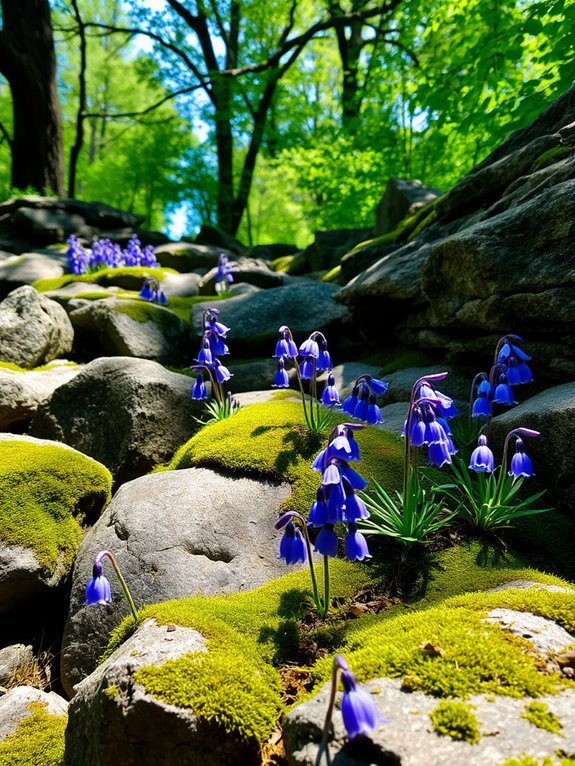
After you’ve enjoyed the bright orange blooms of Butterfly Weed, consider adding a touch of whimsy with Bluebell (Hyacinthoides non-scripta).
These delightful flowers create a carpet of blue that dances in the breeze, inviting you to stop and admire them. They thrive in partial shade and are perfect for those tricky spots in your rock garden.
Their bell-shaped blooms not only charm the eye but also attract bees and butterflies, so you’ll have nature’s little helpers buzzing around.
Plus, they’re just the right size—no need to worry about them taking over! You’ll love their cheerful presence!
Coreopsis (Coreopsis Tinctoria)
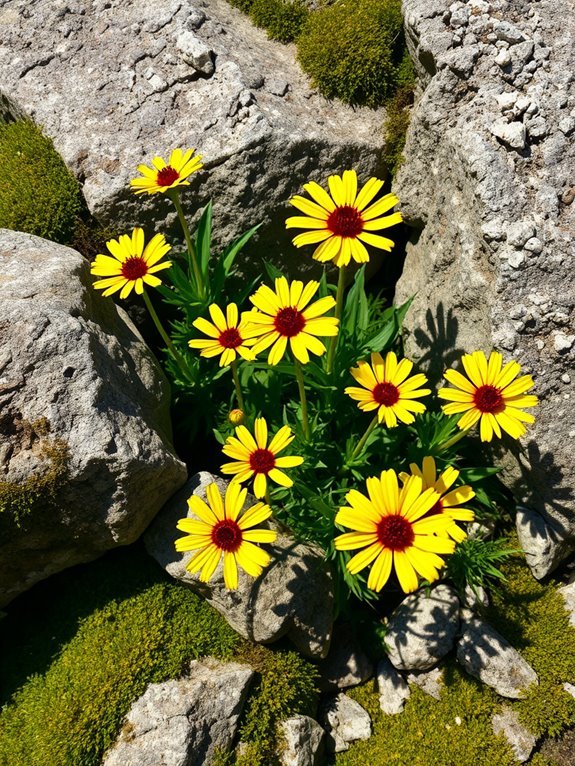
Imagine a burst of sunshine lighting up your rock garden—meet Coreopsis (Coreopsis tinctoria)! This cheerful wildflower, often called tickseed, brings vibrant yellow blooms that dance in the breeze.
You’ll love how easy it’s to grow and maintain.
- Attracts butterflies and pollinators to your garden
- Thrives in poor soil and full sun
- Blooms from late spring to early fall
- Resilient and drought-tolerant once established
With Coreopsis, you’ll have a lively display of color, and who wouldn’t want a bit of sunshine in their garden?
Goldenrod (Solidago Spp.)
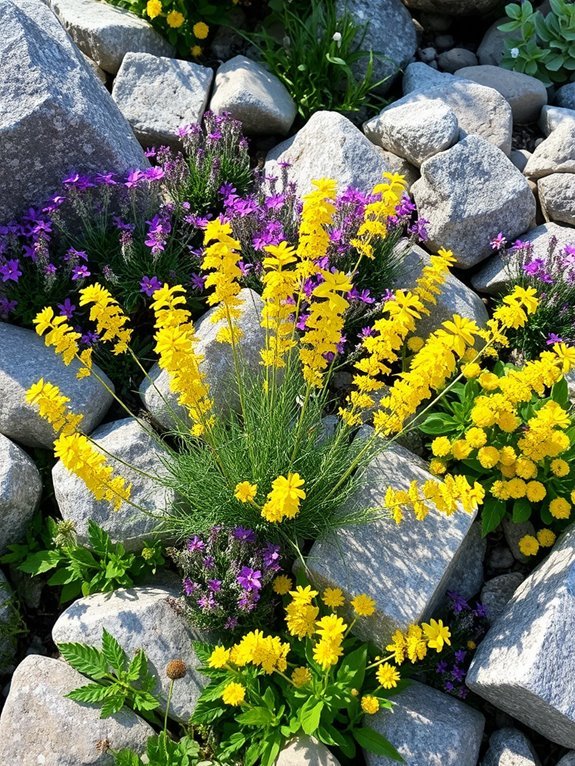
If you’re looking to add a touch of golden charm to your rock garden, Goldenrod (Solidago spp.) is the perfect choice!
This vibrant wildflower bursts into bloom late summer, showcasing clusters of bright yellow flowers that dance in the breeze. Not only does it attract butterflies and bees, but it also thrives in poor soil, making it a low-maintenance superstar.
Imagine those golden blooms contrasting beautifully against rocky backdrops. Just be careful—some varieties can spread like gossip at a family reunion!
Plant them wisely, and you’ll enjoy a cheerful, lively garden that’s sure to impress your visitors.
Harebell (Campanula Rotundifolia)
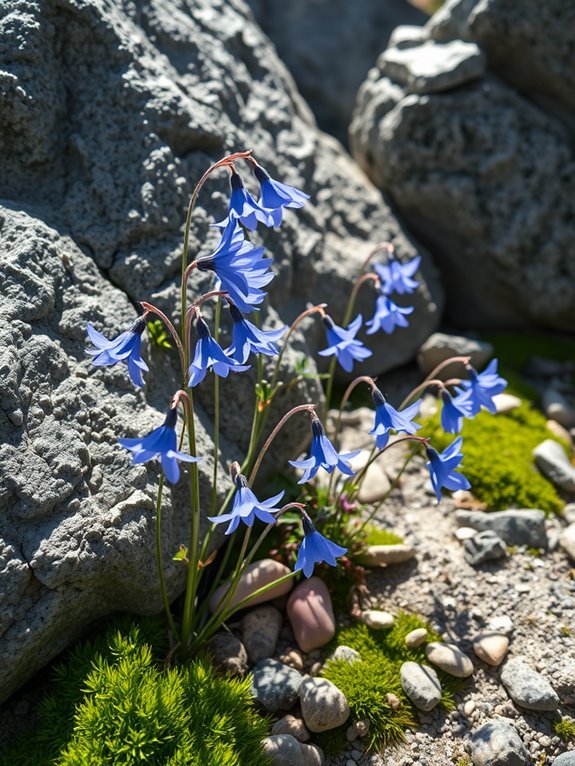
Harebell (Campanula rotundifolia) is like a delicate little bell that rings beauty in your rock garden! These charming flowers add a whimsical touch, swaying gently in the breeze.
You’ll love how they create a serene atmosphere, perfect for relaxation.
- They’re drought-tolerant, making them easy to care for!
- Their lovely blue-violet hue attracts butterflies and bees, enhancing your garden’s vibrancy.
- Harebells thrive in rocky, well-drained soil, so they fit right in!
- They bloom from late spring to early fall, providing lasting color.
Add harebells to your collection, and watch your garden sing with joy!
Indian Paintbrush (Castilleja Spp.)
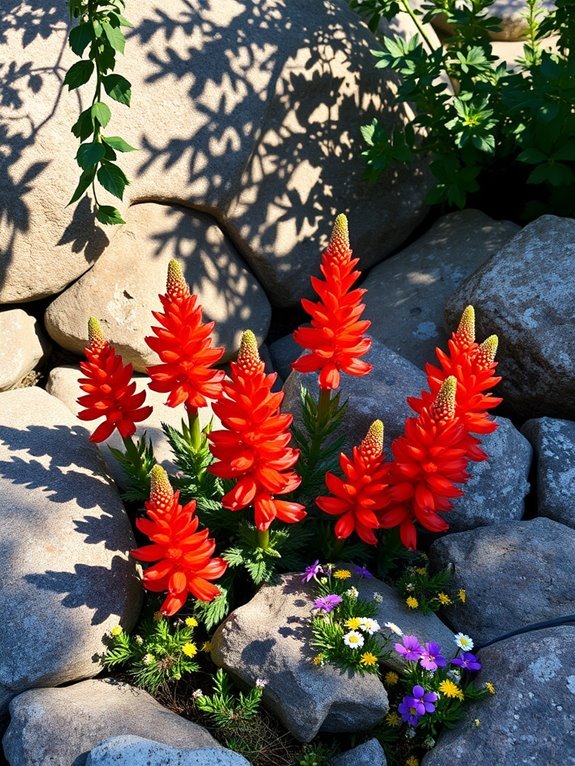
After adding those enchanting harebells to your rock garden, you might want to contemplate the bold and vibrant Indian paintbrush (Castilleja spp.) for a splash of color!
These wildflowers boast fiery red, orange, or yellow hues, making them a showstopper. They thrive in well-drained soil and full sun, so pick the perfect spot.
Plus, they’re not just pretty faces! Indian paintbrushes are hemiparasitic, meaning they tap into neighboring plants for nutrients.
Just imagine the delightful contrast of their fiery blooms against the cool rocks.
Meadow Rue (Thalictrum Spp.)
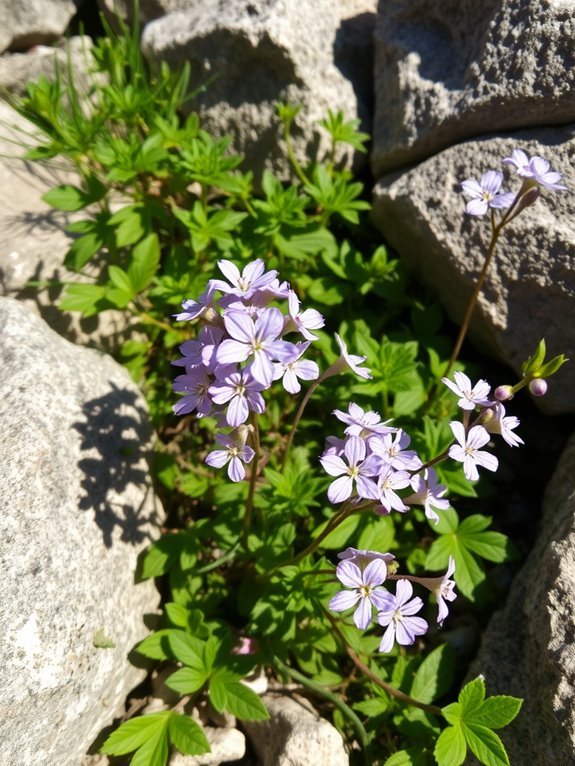
When designing your rock garden, consider adding the delicate charm of meadow rue (Thalictrum spp.) to the mix!
These lovely plants bring a touch of elegance with their feathery foliage and airy flower clusters, making your garden feel enchanting. Plus, they’re low-maintenance, so you can enjoy their beauty without too much fuss.
- Attracts pollinators like bees and butterflies
- Thrives in partial shade, perfect for tricky spots
- Pairs well with other wildflowers for a stunning display
- Provides vertical interest with varying heights
Foxglove (Digitalis Purpurea)
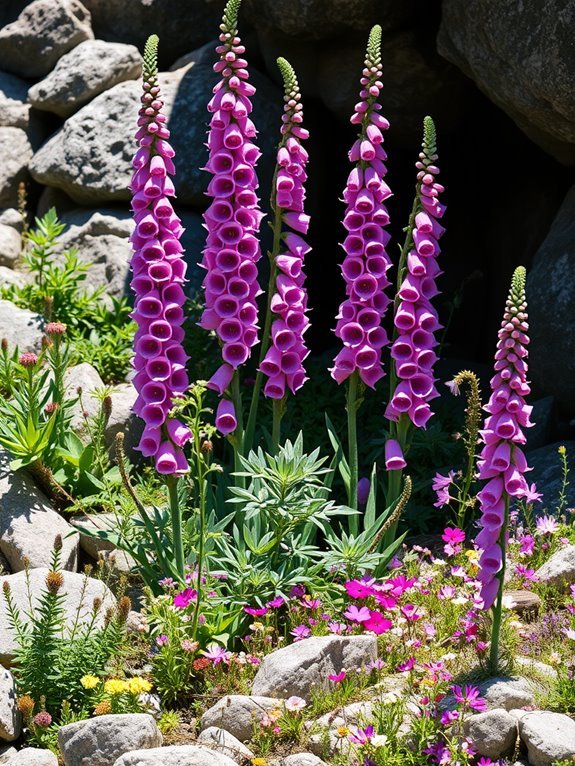
Imagine stepping into your rock garden and being greeted by the vibrant, trumpet-shaped blooms of foxglove (Digitalis purpurea).
These beauties can tower over your other plants, creating a stunning visual impact. With colors ranging from soft pastels to bold purples, they’ll make your garden pop!
Just be careful, though—while they’re gorgeous, all parts of the plant are toxic if ingested, so keep curious pets and kids at bay.
Plant foxglove in a partially shaded area, and you’ll see them thrive. Trust me, their elegance and charm will have you smiling every time you stroll through your garden!
Phlox (Phlox Paniculata)
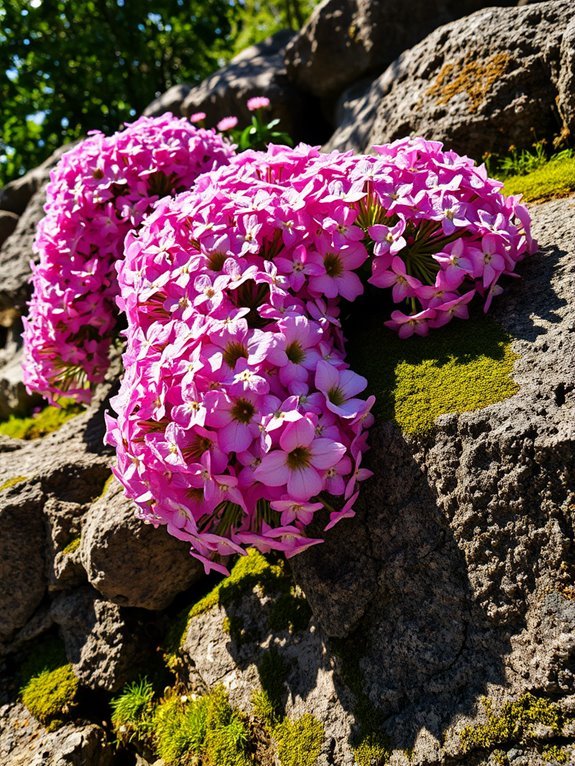
Phlox (Phlox paniculata) brings a burst of color and cheer to your rock garden, and it’s hard not to smile when you see their clusters of vibrant blooms swaying in the breeze.
These cheerful flowers are perfect for making your garden pop with color and attracting pollinators.
- They’re hardy and easy to grow.
- You can find them in various colors, from pink to purple.
- They thrive in sunny spots but tolerate a little shade.
- Phlox can even bloom in summer, keeping your garden lively.
Wild Lupine (Lupinus Perennis)
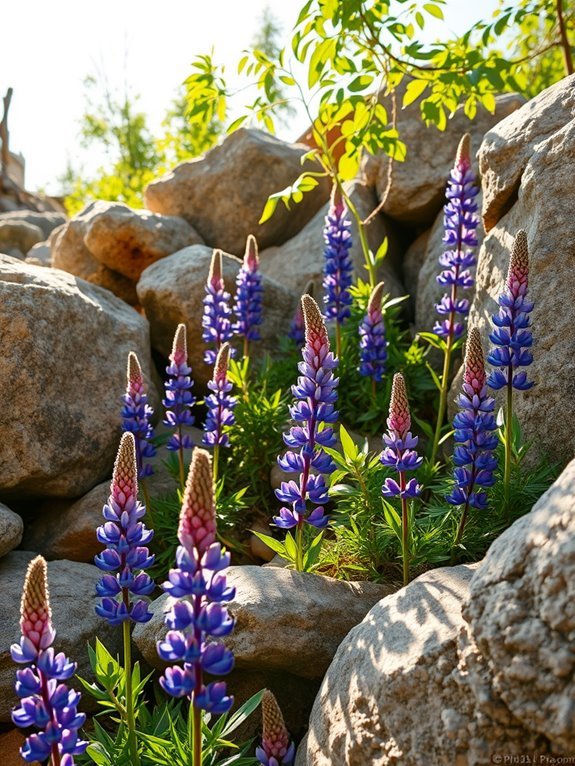
If you’re looking to add a splash of whimsy and a touch of wild beauty to your rock garden, Wild Lupine (Lupinus perennis) might just be the perfect choice for you!
This charming perennial dazzles with tall spikes of blue, purple, or white flowers that nod gracefully in the breeze. Not only do they attract butterflies, but their feathery foliage adds texture and interest.
Plus, these hardy plants love sandy or rocky soil, so they fit right in! Just remember, they prefer full sun and well-drained spots.
With Wild Lupine, your garden will become a vibrant, eye-catching haven!
Columbine (Aquilegia Canadensis)
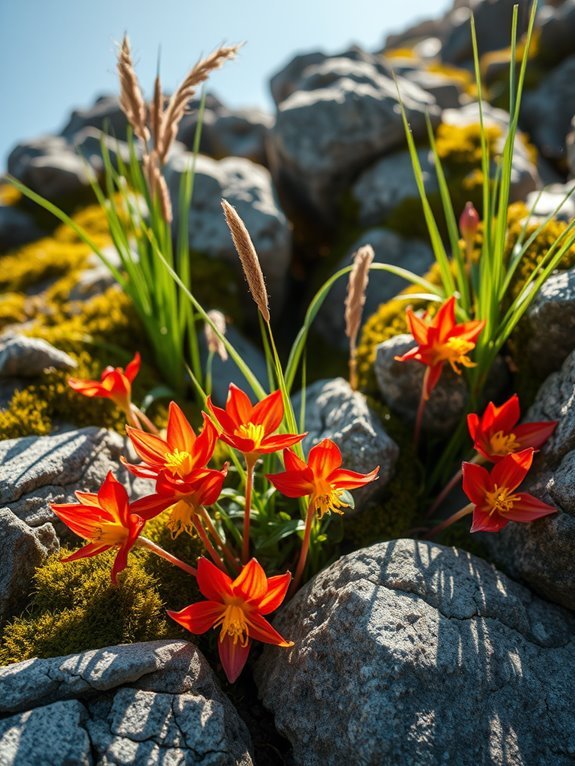
When you think of adding a splash of color and charm to your rock garden, Columbine (Aquilegia canadensis) should definitely be on your list!
With its unique, whimsical flowers and delicate foliage, it’ll steal the show. You’ll love how easy it’s to grow and how it attracts hummingbirds like a magnet!
- Gorgeous red and yellow blooms
- Tolerates partial shade, perfect for tricky spots
- Attracts pollinators, boosting your garden’s ecosystem
- Self-seeding, so you’ll get surprises each year
Plant Columbine, and watch your garden transform into a vibrant paradise! It’s like nature’s confetti!
Virginia Bluebell (Mertensia Virginica)
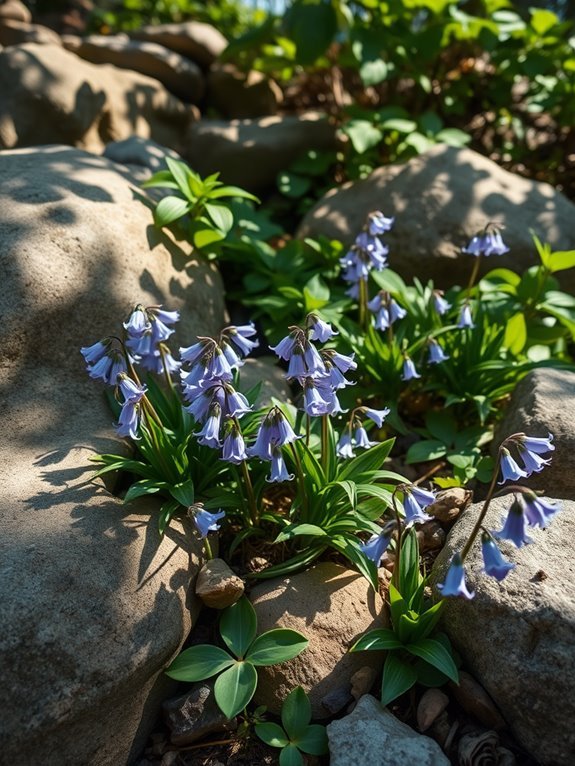
Imagine a gentle breeze rustling through your rock garden, accompanied by the cheerful bell-shaped flowers of Virginia Bluebell (Mertensia virginica).
These lovely perennials bloom in spring, showcasing clusters of blue flowers that dance like little bells. They thrive in moist, shady spots, making them perfect companions for your rocks.
As they grow, their foliage adds a lush green touch, creating a vibrant backdrop. Plus, they’re a magnet for pollinators, bringing delightful bees and butterflies to your garden.
Plant them in groups for a stunning display, and watch as your garden transforms into a whimsical wonderland. Who wouldn’t love that?
Shepherd’s Purse (Capsella Bursa-Pastoris)
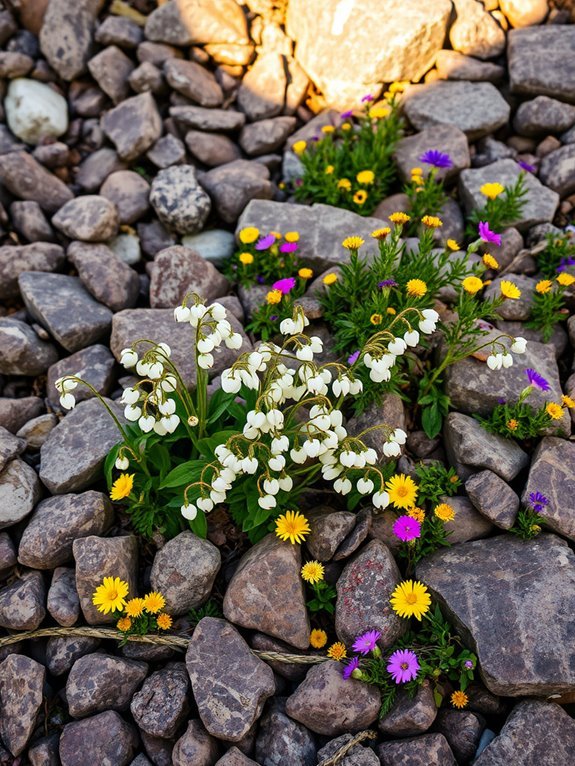
As you stroll through your rock garden, you might be surprised to find the charming Shepherd’s Purse (Capsella bursa-pastoris) adding a touch of whimsy among the stones.
This delightful little wildflower, with its heart-shaped seed pods, is both pretty and practical. It’s a resilient plant that thrives in rocky crevices, making it an ideal companion for your garden.
- Attracts beneficial pollinators
- Edible leaves for adventurous eaters
- Low maintenance and drought-resistant
- Unique seed pods resemble tiny purses
With its playful appearance, Shepherd’s Purse will surely steal your heart while enhancing your garden’s natural charm!
Wild Strawberry (Fragaria Vesca)
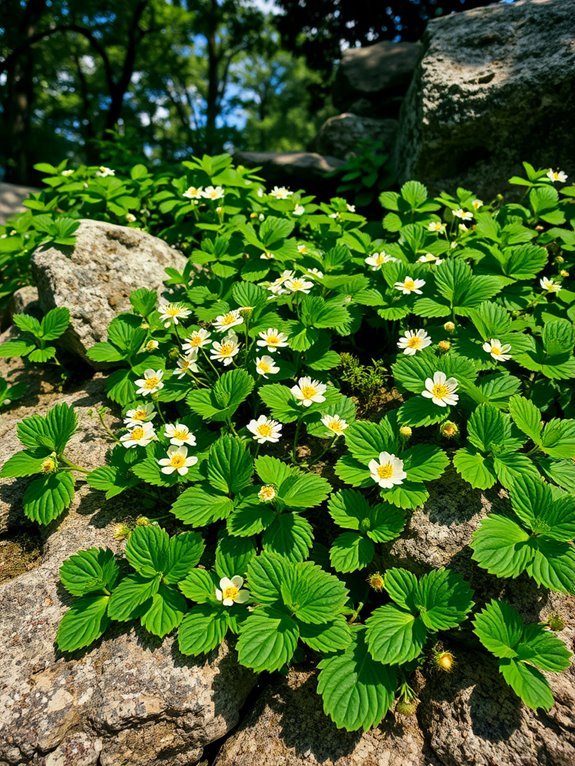
Nestled among the stones, you’ll likely encounter the delightful Wild Strawberry (Fragaria vesca), a little treasure that brings both beauty and a burst of flavor to your rock garden.
With its charming white flowers and luscious red berries, this plant not only looks great but also invites delightful snacking. Imagine plucking a sweet strawberry while wandering through your garden!
They thrive in well-drained soil and need a bit of sun, making them perfect for those sunny spots. Plus, they’re a favorite for birds and butterflies, so you’ll enjoy a lively garden.
Who knew gardening could taste this good?
Creeping Thyme (Thymus Serpyllum)
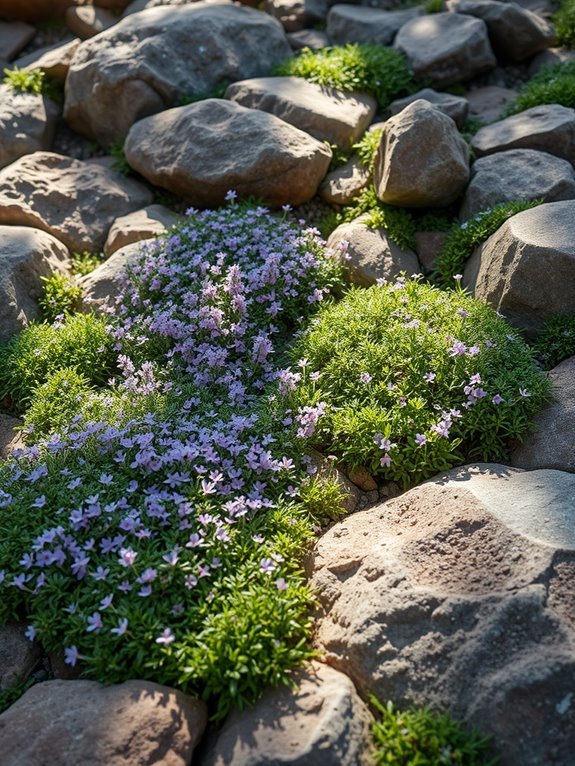
Creeping Thyme (Thymus serpyllum) is like the charming carpet of your rock garden, adding a splash of green that’s both beautiful and practical.
This resilient plant thrives in rocky spots, bringing life to those hard-to-fill areas. Plus, it releases a delightful aroma when stepped on—who doesn’t love a fragrant garden?
- Attracts pollinators like bees and butterflies
- Drought-tolerant, making it low-maintenance
- Offers lovely purple flowers in summer
- Perfect for edging or filling gaps
Frequently Asked Questions
What Are the Best Soil Types for Wildflowers in Rock Gardens?
To grow wildflowers in rock gardens, you’ll want well-draining sandy or gravelly soil. It should be low in nutrients to mimic natural conditions, so your wildflowers thrive without excessive fertilization.
How Do I Attract Pollinators to My Rock Garden?
Imagine a vibrant garden buzzing like a Shakespearean play. To attract pollinators, plant diverse flowers, choose native species, and avoid pesticides. Create sunny spots and provide water sources. They’ll flock to your enchanting rock garden!
When Is the Best Time to Plant Wildflowers?
The best time to plant wildflowers is in early spring or fall, depending on your climate. You’ll guarantee ideal growth and blooming by choosing the right season, allowing these beautiful flowers to thrive in your garden.
Can I Grow Wildflowers in Shady Areas?
Yes, you can grow wildflowers in shady areas, but they’ll thrive best with dappled sunlight. Imagine vibrant blooms peeking through a canopy of leaves, adding color where light struggles to reach. Choose shade-tolerant varieties for success.
How Do I Maintain Wildflowers Once Established?
Once you establish wildflowers, maintain them by regularly checking for weeds, ensuring adequate moisture, and deadheading spent blooms. You’ll also want to monitor for pests and diseases to keep your flowers thriving throughout the season.
Conclusion
Wildflowers can transform your rock garden into a beautiful haven. Imagine the vibrant Black-Eyed Susans swaying in the wind and delicate Harebells adding a touch of grace.
With lively colors and natural charm, your garden can attract butterflies and bees. Get ready to dig in and let wildflowers bring your outdoor space to life!




